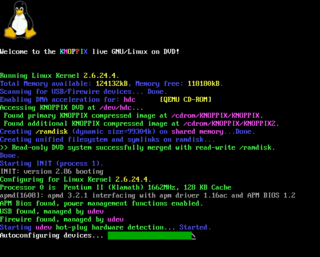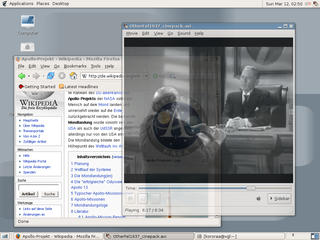
The X Window System is a windowing system for bitmap displays, common on Unix-like operating systems.

The Linux framebuffer (fbdev) is a linux subsystem used to show graphics on a computer monitor, typically on the system console.

In computing, a windowing system is a software suite that manages separately different parts of display screens. It is a type of graphical user interface (GUI) which implements the WIMP paradigm for a user interface.
DirectFB was a software library with a small memory footprint that provides graphics acceleration, input device handling and abstraction layer, and integrated windowing system with support for translucent windows and multiple display layers on top of the Linux framebuffer without requiring any kernel modifications. DirectFB is free and open-source software subject to the terms of the GNU Lesser General Public License (LGPL).
X.Org Server is the free and open-source implementation of the X Window System (X11) display server stewarded by the X.Org Foundation.
The X video extension, often abbreviated as XVideo or Xv, is a video output mechanism for the X Window System. The protocol was designed by David Carver; the specification for version 2 of the protocol was written in July 1991. It is mainly used today to resize video content in the video controller hardware in order to enlarge a given video or to watch it in full screen mode. Without XVideo, X would have to do this scaling on the main CPU. That requires a considerable amount of processing power, which could slow down or degrade the video stream; video controllers are specifically designed for this kind of computation, so can do it much more cheaply. Similarly, the X video extension can have the video controller perform color space conversions, and change the contrast, brightness, and hue of a displayed video stream.
RFB is an open simple protocol for remote access to graphical user interfaces. Because it works at the framebuffer level it is applicable to all windowing systems and applications, including Microsoft Windows, macOS, the X Window System and Wayland. RFB is the protocol used in Virtual Network Computing (VNC) and its derivatives.

Xinerama is an extension to the X Window System that enables X applications and window managers to use two or more physical displays as one large virtual display.

The Direct Rendering Infrastructure (DRI) is the framework comprising the modern Linux graphics stack which allows unprivileged user-space programs to issue commands to graphics hardware without conflicting with other programs. The main use of DRI is to provide hardware acceleration for the Mesa implementation of OpenGL. DRI has also been adapted to provide OpenGL acceleration on a framebuffer console without a display server running.
The Direct Rendering Manager (DRM) is a subsystem of the Linux kernel responsible for interfacing with GPUs of modern video cards. DRM exposes an API that user-space programs can use to send commands and data to the GPU and perform operations such as configuring the mode setting of the display. DRM was first developed as the kernel-space component of the X Server Direct Rendering Infrastructure, but since then it has been used by other graphic stack alternatives such as Wayland and standalone applications and libraries such as SDL2 and Kodi.

Xgl is an obsolete display server implementation supporting the X Window System protocol designed to take advantage of modern graphics cards via their OpenGL drivers, layered on top of OpenGL. It supports hardware acceleration of all X, OpenGL and XVideo applications and graphical effects by a compositing window manager such as Compiz or Beryl. The project was started by David Reveman of Novell and first released on January 2, 2006. It was removed from the X.org server in favor of AIGLX on June 12, 2008.

A free and open-source graphics device driver is a software stack which controls computer-graphics hardware and supports graphics-rendering application programming interfaces (APIs) and is released under a free and open-source software license. Graphics device drivers are written for specific hardware to work within a specific operating system kernel and to support a range of APIs used by applications to access the graphics hardware. They may also control output to the display if the display driver is part of the graphics hardware. Most free and open-source graphics device drivers are developed by the Mesa project. The driver is made up of a compiler, a rendering API, and software which manages access to the graphics hardware.
Xsun is an X Window System (X11) display server implementation included with Solaris, developed by Sun Microsystems. It replaced the older Xnews server, which supported the display of not only X11 applications, but also NeWS and SunView programs. Xsun discontinued support for these legacy environments, and added support for Display PostScript.

A multiseat, multi-station or multiterminal system is a single computer which supports multiple independent local users at the same time.

nouveau is a free and open-source graphics device driver for Nvidia video cards and the Tegra family of SoCs written by independent software engineers, with minor help from Nvidia employees.

Wayland is a communication protocol that specifies the communication between a display server and its clients, as well as a C library implementation of that protocol. A display server using the Wayland protocol is called a Wayland compositor, because it additionally performs the task of a compositing window manager.

EGL is an interface between Khronos rendering APIs and the underlying native platform windowing system. EGL handles graphics context management, surface/buffer binding, rendering synchronization, and enables "high-performance, accelerated, mixed-mode 2D and 3D rendering using other Khronos APIs." EGL is managed by the non-profit technology consortium Khronos Group.
In computing, SPICE is a remote-display system built for virtual environments which allows users to view a computing "desktop" environment – not only on its computer-server machine, but also from anywhere on the Internet – using a wide variety of machine architectures.

The Linux console is a system console internal to the Linux kernel. A system console is the device which receives all kernel messages and warnings and which allows logins in single user mode. The Linux console provides a way for the kernel and other processes to send text output to the user, and to receive text input from the user. The user typically enters text with a computer keyboard and reads the output text on a computer monitor. The Linux kernel supports virtual consoles – consoles that are logically separate, but which access the same physical keyboard and display. The Linux console are implemented by the VT subsystem of the Linux kernel, and do not rely on any user space software. This is in contrast to a terminal emulator, which is a user space process that emulates a terminal, and is typically used in a graphical display environment.
Nvidia Optimus is a computer GPU switching technology created by Nvidia which, depending on the resource load generated by client software applications, will seamlessly switch between two graphics adapters within a computer system in order to provide either maximum performance or minimum power draw from the system's graphics rendering hardware.














